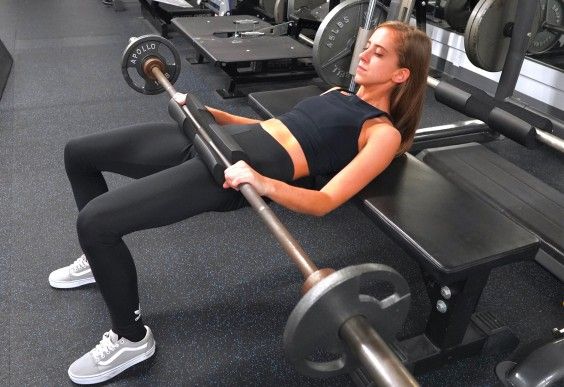Believe it or not, butts are meant to do much more than just look amazing in tight jeans—giving your glutes the TLC they deserve helps strengthen and prevent pain in our hips, low back, and knees. And when it comes to building a strong backside, we don’t know anyone who knows more than Bret Contreras, PhD, CSCS—seriously, people call him the “Glute Guy.”
Of course, training our entire bodies is important, but Contreras believes that a strong posterior chain is an essential part of any strength-training program. That’s why he’s created an entire strength and conditioning program centered around—yep, you guessed it—the glutes.
To get started strengthening those cheeks, check out Contreras’s four favorite butt-building exercises below. And if you’re really chasing booty gains? Contreras says practicing these moves three times a week for two months will show serious results.
1. Barbell Hip Thrust

While watching a UFC fight in 2006, Contreras noticed one of the fighters had an ineffective hip bump, which he thought was due to weak glutes. So he went into his garage and toyed around with the idea of putting his back against a bench, his feet on the floor, and a weighted barbell on his lap, thrusting his hips to full extension. This exercise allowed for a full range of motion and the ability to load weight—the perfect glute-focused exercise.
To perform a barbell hip thrust, you need a barbell, weights, and a bench. Start out seated in front of the bench and place the barbell on your lap. With your feet planted on the ground and your back and lats on the bench, thrust your hips up, squeezing your glutes. Pause for a few seconds at the top, then lower your hips to the starting point.
Contreras suggests starting with 65 pounds and doing 3 sets of 12 reps three times a week. Add 10 pounds a week as long as you can fully open your hips and maintain proper form.
2. Goblet Squat
For this exercise, hold one dumbbell at chest level with your hands around one of the heads (holding it upright as if it were goblet full of wine). Descend into a full squat, keeping your elbows between your knees, which Contreras says keeps the knees from caving in at the bottom of the squat. Come up out of the squat by pushing through your heels, driving the knees out, and keeping your torso upright.
Contreras says to aim for 3 sets of 8 to 10 reps with a30-poundd dumbbell three times a week, moving to a heavier dumbbell once the reps start feeling easy.
3. Dumbbell Romanian Deadlift
The Romanian deadlift is a variation on a traditional deadlift where your legs remain relatively straighter and your hips stay higher, which results in targeting the glutes and hamstrings.
To get started, hold a dumbbell in each hand at a 45-degree angle in front of your thighs. Push your hips back like you’re closing a car door with your butt and lower the dumbbells. Keep your knees slightly bent and your back flat by squeezing your core and your shoulder blades together. Once the dumbbells reach about mid-shin—or as low as you can go while still maintaining a flat back—squeeze your glutes and stand up straight.
For the first week, Contreras recommends holding a 25-pound dumbbell in each hand for 3 sets of 10 to 12 reps. Once this feels easy, move to a heavier set of dumbbells.
4. Banded Seated Hip Abduction
For this exercise, you’ll need a small resistance band or Contreras’s own band, called the Glute Loop, which is made of cloth (as opposed to latex).
This move has three different parts:
First, sit on a bench and place the band above your knees. Holding onto the bench, lean backward and pulse your knees out for 30 reps, keeping your feet planted on the ground. Maintain tension on the band for the entire 30 reps by not letting your knees come together. Next, sit up straight and repeat for another 30 reps. Finally, lean forward slightly, still holding onto the bench, and finish with a final 30 reps.
This is a burnout exercise, meaning it’s to be completed at the end of your workout. Working the abductors—muscles on the hip that include the gluteus medius, gluteus minimus, and tensor fasciae latae—helps prevent the knees from coming in during a squat, can improve knee pain, and can help with running gait and agility.
Hilary is a San Diego-based health and fitness writer. Check out her website, or follow her on Instagram at @hilaryachauer.
